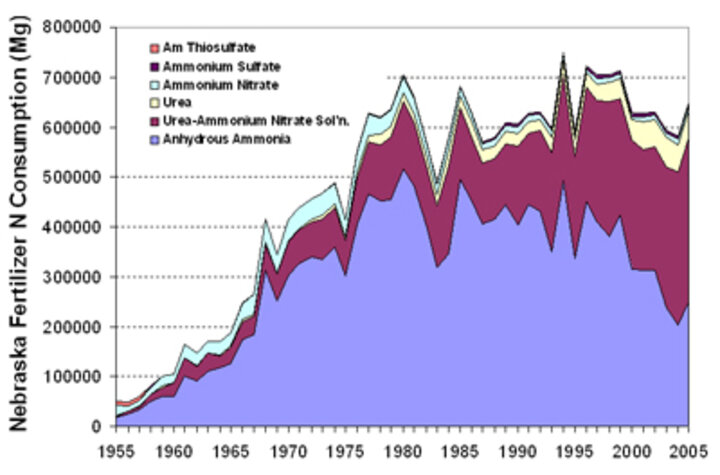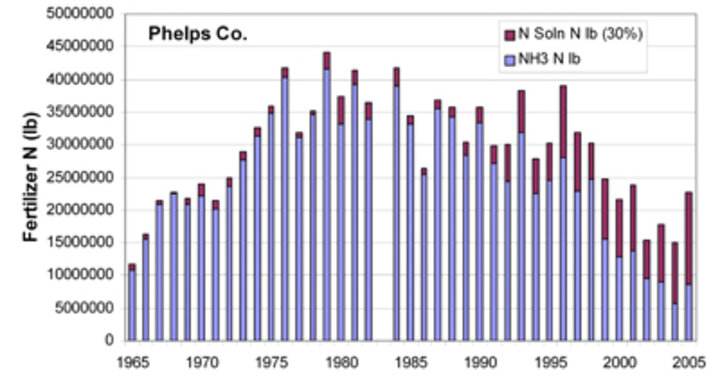March 9, 2007

|
| Figure 1. Nitrogen fertilizer use in Nebraska, 1955-2005. (Source: Nebraska Department of Agriculture) |

|
| Figure 2. Comparison of anhydrous ammonia and nitrogen solution use in Phelps County, 1965-2005. (Source: Nebraska Department of Agriuclture) |

|
| Figure 3. Comparison of anhydrous ammonia and nitrogen solution use in Merrick County, 1965-2005. (Source: Nebraska Department of Agriculture) |
For many years, anhydrous ammonia was the most widely used form of nitrogen (N) fertilizer in Nebraska. Historically the least expensive nitrogen fertilizer, it worked well for corn, sorghum, and other crops where it could be injected into the soil. However, the use of anhydrous ammonia, expressed as the percent of total N used in Nebraska, peaked in 1989, at 73%. Since then, anhydrous ammonia use has steadily declined relative to urea-based fertilizers, to 38% of all N used in Nebraska in 2005 (Figure 1). This decline is related to several factors, including cost of application, safety and liability, flexibility in use of N solution and an increase in fertigation with center pivot irrigation.
| See the Feb. 12, 2007 CropWatch for UNL Revises Nitrogen Recommendation in Light of Improved Corn Prices |
Anhydrous ammonia is a relatively efficient form of N fertilizer because it must be injected below the soil surface. This places the fertilizer into the root zone, below crop residue, and protects it from loss processes such as runoff, volatilization and immobilization. Nitrogen fertilizers are used less efficiently when they are broadcast or left on the soil surface. While producers gain flexibility in timing and placement with UAN and urea, these fertilizers may be used less efficiently by the crop than anhydrous ammonia primarily because of how they are applied. Several management options can increase the efficiency of urea-based fertilizers: injection into the soil, surface band application, use of Agrotain® as a urease inhibitor, slow or controlled release formulations and application of 1/2 inch or more of irrigation water with a sprinkler system after surface application.
The global distribution of natural gas — the primary feedstock for manufacturing nitrogen fertilizers — coupled with transportation and market demands indicate that increasingly urea will be the predominant form of N fertilizer in the US and that much of it will be imported from the Middle East and Russia. We can expect urea-based fertilizers to continue to be the primary N fertilizer in Nebraska as well. Producers should become familiar with factors that reduce the efficiency of urea-based fertilizers and learn how to adapt urea-based fertilizers into their production systems, as the supply of anhydrous ammonia is likely to gradually decline.
Richard B. Ferguson
Extension Soils Specialist
